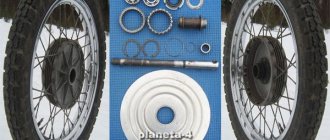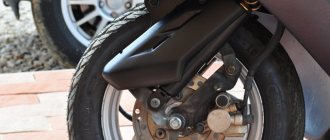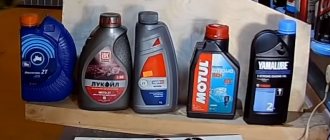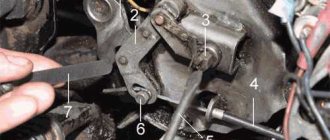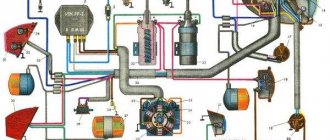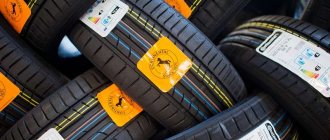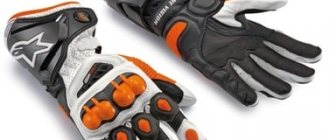One of these nuances is the pressure maintained inside the tires. The characteristic affects:
- quality and maneuverability of management;
- wheel grip on the road;
- volume of fuel consumed;
- contact patch area;
- suspension load;
- tire wear resistance;
- transport dynamics.
Neglecting the level of pressure in motorcycle tires can lead to undesirable consequences. Let's look at how to properly regulate the indicator and the dangers of insufficient or excessive pumping.
What affects motorcycle tire pressure?
Air, like any substance, expands when heated, and when cooled, on the contrary, contracts. This is also true for motorcycle tires - when hot, one level of pressure is maintained inside the tires, and when cold, a completely different one. Setting tire pressure is important, as it is responsible for the most important characteristics for any bike - both for a scooter and for a sports enduro:
- Controllability and maneuverability on dry and wet surfaces;
- The size of the contact patch is directly responsible for traction;
- Suspension operating load;
- Fuel consumption;
- Wear resistance.
In short, only properly inflated tires can effectively fulfill their task - to provide contact with the track and not lose it throughout the entire trip. Any deviation from the norm (lack or excess of pressure) is fraught with unpleasant consequences.
Requirements for specific sports motorcycle models
✔︎ Honda • CBR 1000 • CBR 600 • CB 600 Hornet • CB 900 • CBR 1100 XX Blackbird • CB 1300 • CB 1000 • CB 1100 • CBF 1000 • CBF 600 • VFR 800 • VTR1000
✔︎ Suzuki • GSF 1200 • GSF 1250 • GSX-R 1000 • GSX-R 600 • GSX 1300 Hayabusa • SV 1000 • SV 600 • GSR 600 • GSR 750
✔︎ Yamaha • FJR1300 • FZ1 • FZ6 • FZ8 • FZS 1000 • MT-07 • MT-09 • XJ6 • XJR1300 • YZF-R1 • YZF-R6
✔︎ Kawasaki • ER-6F (Ninja 650R) • ER-6N • GTR1400 • Ninja 650 • Versys 1000 • Versys 650 • Z 1000 • Z 1000SX • Z 650 • Z 750 • ZX-10 Ninja • ZX-6 Ninja • ZZR 1100 • ZZR 1400
How to choose the correct tire pressure?
The front and rear tires must have different pressures, and this is important to understand before picking up a pump. The user manual of any bike always indicates the optimal pressure for cold tires, so if you measure the indicators immediately after a ride, do not be surprised that the pressure gauge will show different values - the air inside has warmed up and expanded.
The manufacturer indicates all parameters for cold tire inflation on a table on the motorcycle frame or in the user manual. They vary depending on the type of motorcycle, but, as a rule, the data varies between 2.0-2.5 Atm for the front wheel and 2.2-2.9 Atm for the rear. If you plan to put another person on the bike, we recommend inflating the tires by 0.2 atm.
| Wheel size | Pressure, front/rear, kgf/cm2 (Atm) | |
| Normal load | Full load | |
| 100/60-10 | 2,2/2,3 | 2,3/2,4 |
| 130/60-13 | 1,8/2,0 | 2,0/2,2 |
| 130/70-12 | 2,2/2,3 | 2,3/2,4 |
| 120/70-12 | 2,25/2,3 | 2,3/2,4 |
| 110/70-12 | 2,2/2,3 | 2,3/2,4 |
| 120/80-12 | 1,8/2,0 | 2,0/2,2 |
| 130/70-10 | 1,8/2,0 | 2,0/2,2 |
| 100/90-10 | 1,9/2,1 | 2,0/2,2 |
| 120/90-10 | 1,8/2,0 | 2,0/2,2 |
| 130/90-10 | 1,9/2,1 | 2,0/2,2 |
| 3,0×10 | 1,75/2,0 | 2,0/2,1 |
| 3.50×10 4PR | 2,5/2,5 | 2,6/2,6 |
Hot pressure depends on many factors, including the rider’s riding style, so they will have to be selected individually for each specific case:
- To begin, inflate the tires to 2-2.3 Atm, taking into account that for the rear tire the pressure should always be 0.3 Atm more than for the front.
- Ride at your normal pace for 10-15 minutes. The pressure in the rear and front tires should increase by an average of 0.2 atm.
- Then use the pressure gauge again: if it shows a value within the normal range of cold pressure, then you have achieved your goal. If it is higher, then lower the wheels; if lower, pump up the tires. Measure the tire pressure and adjust the amount of air inside until you achieve the result.
If you notice that immediately after the start you feel a little discomfort, then this is in the order of things. The rubber needs to warm up a little and in five minutes everything will return to normal.
Theory and practice
We all know that when air is heated, it expands, and when it cools, it occupies less volume. In order to determine what pressure a motorcycle tire should be, it is necessary to clearly determine how the vehicle will be used. Two identical tires, after active driving, may show different pressures, which is associated with warming up the air. Braking, asphalt temperature, and dynamic friction of the tire surface heat up the front and rear wheels differently.
To determine what motorcycle tire pressure is necessary for efficient and safe riding, you can use the following rules:
- Use the documentation and technical manuals that came with your motorcycle. Each manufacturer, in order to carry out certification, conducts a comprehensive assessment of the characteristics of its vehicle based on the results of tests and conclusions. As a result, a mark is placed in the technical passport or manual about the recommended pressure in the tires of the front and rear wheels.
- If you approach the motorcycle from behind, there should be a tire pressure recommendation mark on the swingarm arm. The motorcycle tire pressure table is given below:
- Make your own assessment of ride quality at different pressures and determine the best indicator.
| in English/Japanese – front wheel | 120 / 60 R17 | 2.0 |
| in English/Japanese – rear wheel | 180 / 55 R17 | 2.9 |
The tire pressure on a Minsk motorcycle may not match the pressure on sports or motocross bikes. For example, the average for motorcycles weighing up to 150 kg (without a pilot) should be: 2-2.2 ATM in the front wheel, 2.4-2.6 in the rear .
If you load your work motorcycle and move with a passenger, then the pressure can be increased to 2.6-2.9 Atm. On average, the correction per passenger should be about 0.2 Atm. Conversely, the pressure in the tires of a motocross motorcycle should be reduced when entering the track before active riding.
Correctly set pressure will not only reduce fuel consumption and extend their service life, but will also dramatically increase the controllability of the motorcycle at high speeds, when turning or overtaking.
What will be the consequences of under/excess pressure in motorcycle tires?
If you overinflate your tires, get ready for the contact patch to decrease, and along with it, the grip characteristics will deteriorate, the ride will become much harsher, there is a possibility of vibration, and the load on the suspension will also increase significantly. Riding in overinflated tires on a wet road is quite dangerous, since due to the small contact zone, the motorcycle will begin to skid when turning and brake poorly. The most unpleasant consequence will be a deterioration in strength and wear resistance. A motorcycle tire can even explode when driving on hot asphalt - one pebble can ruin everything.
Increased tire pressure is used only in two cases: if there is another passenger on the motorcycle or during long high-speed rides.
Underinflated tires have their own list of problems: their contact patch may be larger, but due to its irregular shape it wears out and deforms extremely quickly. Among the useful qualities of rubber, handling, maneuverability, directional stability and fuel consumption are seriously affected. Eventually, if you don't correct the pressure in your motorcycle tires, you will end up with cord separation. If your motorcycle has wheels with tubed tires, then insufficient inflation of the tubes will sooner or later lead to accidental dismounting.
Riding on underinflated tires is practiced only on special enduro sports motorcycles for performing off-road stunts.
However, in order to safely drive a motorcycle, it is not enough to simply set the correct tire pressure and leave it at that - we also recommend that you refer to the speed index table.
| Speed index | Maximum speed, km/h |
| A | 40 |
| B | 50 |
| C | 60 |
| D | 65 |
| E | 70 |
| F | 80 |
| G | 90 |
| J | 100 |
| K | 110 |
| L | 120 |
| M | 130 |
| N | 140 |
| P | 150 |
| Q | 160 |
| R | 170 |
| S | 180 |
| T | 190 |
| U | 200 |
| H | 210 |
| V | 240 |
| W | 270 |
| Y | 300 |
| VR | >210 |
| ZR | >240 |
| (W) | >270 |
| Z | >300 |
It is prohibited to install tires with a low speed index on high-speed motorcycles - they may not cope with the capabilities of the motorcycle, which will not lead to anything good.
What happens if you overinflate your tires?
A common mistake novice bikers make is overinflating tires due to the fact that in the first minutes after the start the pilot feels inconvenience and excess grip. If you overinflate the wheels, the contact patch will decrease, the traction characteristics will decrease, the ride will become harsh, and the likelihood of shaking and vibration will increase. Riding a bike with overinflated tires negatively affects the condition of the suspension. Over time, a part may become deformed, break, or require serious, expensive repairs.
Driving with overinflated inner tubes is especially dangerous in rainy weather. Due to poor contact with the road, motor vehicles may begin to skid when turning. In such conditions, the braking system does not always work properly, creating the preconditions for a traffic accident.
An unpleasant and dangerous consequence of overpumping is a decrease in strength and wear resistance. A motorcycle tire can simply explode while driving on a hot or uneven highway.
Riding on overinflated tires is only allowed in the following cases:
- the bike carries a passenger or transports a heavy load comparable to the weight of a person;
- during long high-speed trips.
Important! The pressure gauge readings can be increased by a couple of tenths during frosts. This will compensate for the low temperature and improve control.
Features of motorcycle wheels
On a motorcycle, as on any vehicle, it is necessary to regularly check the tire pressure. Considering the speeds at which motorcycles of our time are capable of moving, and the angles at which they are capable of leaning, it is imperative to maintain pressure. Keep in mind that underinflated tires can affect the motorcycle's handling and control feel. When pumped, the contact patch decreases. When driving a motorcycle, in both cases the movement is dangerous.
You also need to take into account that a motorcycle tire is different from a car tire; the pressure in it is measured differently. The hot pressure is measured after several minutes of riding the motorcycle, that is, after you have already ridden it. Cold pressure is the measurement immediately before you start driving, that is, before you go anywhere.
Practical recommendations
Motorcycle tires need to maintain optimal pressure, which requires regular monitoring. If the recommended parameters are unknown, then the tires can be inflated to an average level of up to two atmospheres. This option is suitable temporarily for imported models.
When you set the correct tire pressure, you will feel unsure of control at first when driving. But after just a few minutes of driving, these sensations will disappear, and you will move with the correct pressure.
You should also remember that the rear wheel always heats up much more than the front wheel. Therefore, the pressure ahead when cold should be a little higher. After heating up, the pressure will be equalized when driving, so the grip on the road surface will be better, and the level of controllability of the motorcycle will also increase.
Rules for determining optimal pressure
The pressure should be measured before driving, in a cold state.
It is worth considering that as the temperature in the tires increases, the pressure will also increase. For example, if the indicator increases by ten degrees, the pressure will increase by one tenth of an atmosphere. It must be remembered that the pressure should be as recommended by the motorcycle manufacturer. This parameter, as well as other characteristics, can be found in the instructions for use. If it is missing, then the recommended parameters can be seen on the symbols. In foreign models they are usually located on the frames or rear wheel joints.

